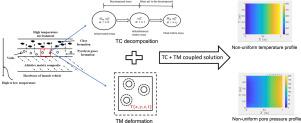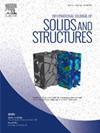Constitutive modeling of thermo-chemical decomposition and thermo-mechanical deformation, coupled with transient heat conduction, in ablative matrix composite
IF 3.4
3区 工程技术
Q1 MECHANICS
International Journal of Solids and Structures
Pub Date : 2024-10-23
DOI:10.1016/j.ijsolstr.2024.113100
引用次数: 0
Abstract
Several thermal protection systems employ sacrificial composite layer that undergoes thermo-chemical decomposition in high-temperature environment. This results in the pyrolysis gas formation (endothermic reaction) that gets trapped inside the voids generated in the ablative matrix phase. These trapped gases apply pore pressure on the structure, along with the mechanical loading, thus significantly influencing the structure failure. A novel thermo-chemical (TC) decomposition and thermo-mechanical (TM) deformation-based coupled multi-physics formulation, applicable to ablative composite systems, is thus presented. A novel shrinkage expression, due to ablative matrix decomposition, is derived. The TC + TM coupled formulation is converted to stress update process, and its results are validated against the available experimental data. The proposed formulation is also converted to boundary value problem employing non-linear finite element framework (NL-FEM). The Jacobian matrices, for one- and two-dimensional cases, are systematically derived, and the proposed NL-FEM formulation is successfully verified against several benchmark problems.
The transient heat conduction equation is finally coupled with the proposed TC + TM formulation (one-way coupling) thus enabling the analysis of more realistic situations where the constant heating rate assumption is not valid. The coupled formulation is finally implemented for several test cases and it is demonstrated that, it has a significant influence on pore pressure and porosity evolution (through pore volumetric strain) within the ablative matrix phase.

烧蚀基复合材料热化学分解和热机械变形以及瞬态热传导的结构建模
一些热防护系统采用的牺牲复合材料层在高温环境下会发生热化学分解。这导致热解气体的形成(内热反应),并被截留在烧蚀基质相中产生的空隙内。这些被截留的气体与机械负载一起对结构产生孔隙压力,从而严重影响结构的失效。因此,本文提出了一种适用于烧蚀复合材料系统的新型热化学(TC)分解和热机械(TM)变形耦合多物理场计算方法。由于烧蚀基质分解,得出了一种新的收缩表达式。TC + TM 耦合公式转换为应力更新过程,其结果与现有实验数据进行了验证。此外,还利用非线性有限元框架(NL-FEM)将提议的公式转换为边界值问题。最后将瞬态热传导方程与提议的 TC + TM 公式(单向耦合)进行耦合,从而能够分析恒定加热速率假设无效的更现实情况。该耦合公式最终在几个测试案例中得到了应用,并证明它对烧蚀基质相内的孔隙压力和孔隙率演变(通过孔隙体积应变)具有重大影响。
本文章由计算机程序翻译,如有差异,请以英文原文为准。
求助全文
约1分钟内获得全文
求助全文
来源期刊
CiteScore
6.70
自引率
8.30%
发文量
405
审稿时长
70 days
期刊介绍:
The International Journal of Solids and Structures has as its objective the publication and dissemination of original research in Mechanics of Solids and Structures as a field of Applied Science and Engineering. It fosters thus the exchange of ideas among workers in different parts of the world and also among workers who emphasize different aspects of the foundations and applications of the field.
Standing as it does at the cross-roads of Materials Science, Life Sciences, Mathematics, Physics and Engineering Design, the Mechanics of Solids and Structures is experiencing considerable growth as a result of recent technological advances. The Journal, by providing an international medium of communication, is encouraging this growth and is encompassing all aspects of the field from the more classical problems of structural analysis to mechanics of solids continually interacting with other media and including fracture, flow, wave propagation, heat transfer, thermal effects in solids, optimum design methods, model analysis, structural topology and numerical techniques. Interest extends to both inorganic and organic solids and structures.

 求助内容:
求助内容: 应助结果提醒方式:
应助结果提醒方式:


